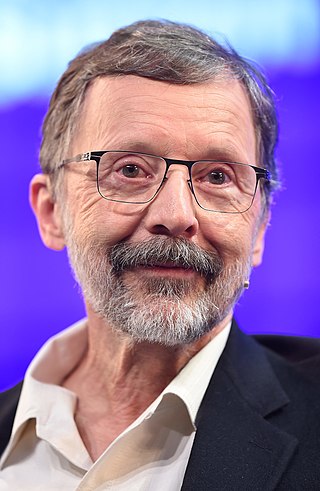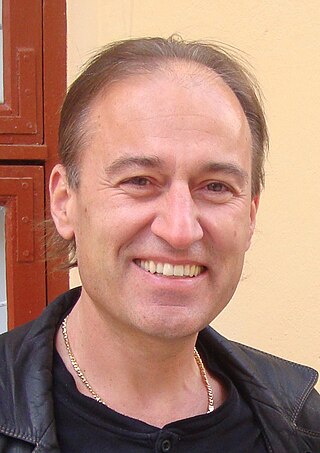
Rendering or image synthesis is the process of generating a photorealistic or non-photorealistic image from a 2D or 3D model by means of a computer program. The resulting image is referred to as the render. Multiple models can be defined in a scene file containing objects in a strictly defined language or data structure. The scene file contains geometry, viewpoint, texture, lighting, and shading information describing the virtual scene. The data contained in the scene file is then passed to a rendering program to be processed and output to a digital image or raster graphics image file. The term "rendering" is analogous to the concept of an artist's impression of a scene. The term "rendering" is also used to describe the process of calculating effects in a video editing program to produce the final video output.
Metropolis light transport (MLT) is a global illumination application of a variant of the Monte Carlo method called the Metropolis–Hastings algorithm to the rendering equation for generating images from detailed physical descriptions of three-dimensional scenes.

Edwin Earl "Ed" Catmull is an American computer scientist who is the co-founder of Pixar and was the President of Walt Disney Animation Studios. He has been honored for his contributions to 3D computer graphics, including the 2019 ACM Turing Award.

Scientific visualization is an interdisciplinary branch of science concerned with the visualization of scientific phenomena. It is also considered a subset of computer graphics, a branch of computer science. The purpose of scientific visualization is to graphically illustrate scientific data to enable scientists to understand, illustrate, and glean insight from their data. Research into how people read and misread various types of visualizations is helping to determine what types and features of visualizations are most understandable and effective in conveying information.

Softimage, Co. was a company located in Montreal, Quebec, Canada that produced 3D animation software. A subsidiary of Microsoft in the 1990s, it was sold to Avid Technology, who would eventually sell the name and assets of Softimage's 3D-animation business to Autodesk.
Mental Ray is a production-quality ray tracing application for 3D rendering. Its Berlin-based developer Mental Images was acquired by Nvidia in 2007 and Mental Ray was discontinued in 2017.

Lance J. Williams was a prominent graphics researcher who made major contributions to texture map prefiltering, shadow rendering algorithms, facial animation, and antialiasing techniques. Williams was one of the first people to recognize the potential of computer graphics to transform film and video making.
Pixar RenderMan is proprietary photorealistic 3D rendering software produced by Pixar Animation Studios. Pixar uses RenderMan to render their in-house 3D animated movie productions and it is also available as a commercial product licensed to third parties. In 2015, a free non-commercial version of RenderMan became available.

Graphic art software is a subclass of application software used for graphic design, multimedia development, stylized image development, technical illustration, general image editing, or simply to access graphic files. Art software uses either raster or vector graphic reading and editing methods to create, edit, and view art.

Ray-tracing hardware is special-purpose computer hardware designed for accelerating ray tracing calculations.
Wavefront Technologies was a computer graphics company that developed and sold animation software used in Hollywood motion pictures and other industries. It was founded in 1984, in Santa Barbara, California, by Bill Kovacs, Larry Barels, Mark Sylvester. They started the company to produce computer graphics for movies and television commercials, and to market their own software, as there were no off-the-shelf computer animation tools available at the time. In 1995, Wavefront Technologies was acquired by Silicon Graphics, and merged with Alias Research to form Alias|Wavefront.
Form·Z is a general-purpose solid and surface modeling software. It offers 2D/3D form manipulating and sculpting capabilities. It can be used on Windows and Macintosh computers. It is available in English, German, Italian, Spanish, French, Greek, Korean and Japanese languages.

Computer graphics deals with generating images and art with the aid of computers. Today, computer graphics is a core technology in digital photography, film, video games, digital art, cell phone and computer displays, and many specialized applications. A great deal of specialized hardware and software has been developed, with the displays of most devices being driven by computer graphics hardware. It is a vast and recently developed area of computer science. The phrase was coined in 1960 by computer graphics researchers Verne Hudson and William Fetter of Boeing. It is often abbreviated as CG, or typically in the context of film as computer generated imagery (CGI). The non-artistic aspects of computer graphics are the subject of computer science research.
Lightwork Design Ltd. is a computer software company specialising in 3D Rendering software. Its headquarters are in Sheffield, United Kingdom.

Markus Gross is a Professor of Computer science at the Swiss Federal Institute of Technology Zürich (ETH), head of its Computer Graphics Laboratory, and the director of Disney Research, Zurich. His research interests include physically based modeling, computer animation, immersive displays, and video technology. He has published more than 430 scientific papers on algorithms and methods in the field of computer graphics and computer vision, and holds more than 30 patents. He has graduated more than 60 Ph.D. students.
Matt Pharr is an American computer graphics researcher and writer, and one of the primary originators of the physically based rendering process. His research focuses on rendering algorithms, graphics processing units, as well as scientific illustration and visualization.
Rahul Chandrakant Thakkar is an Indian-American software inventor who was one of the 33 recipients of Academy Award for scientific and technical achievement in 2016. Thakkar won the Academy Award for creating the "groundbreaking design" of DreamWorks Animation Media Review System, a scalable digital film review platform.

Gary Yost is an American filmmaker and software designer, best known for leading the team that created Autodesk 3ds Max.

Nvidia RTX is a professional visual computing platform created by Nvidia, primarily used in workstations for designing complex large-scale models in architecture and product design, scientific visualization, energy exploration, and film and video production, as well as being used in mainstream PCs for gaming.










